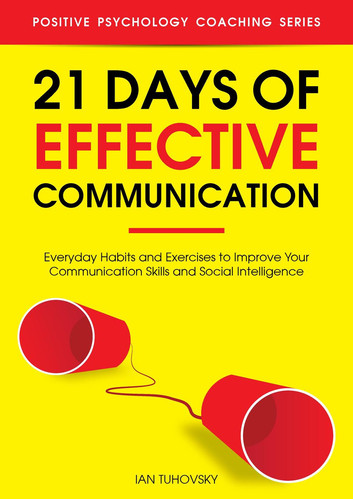“21 Days of Effective Communication: Everyday Habits and Exercises to Improve Your Communication Skills and Social Intelligence” by Ian Tuhovsky provides practical guidance for enhancing communication skills over a three-week period. Here’s a ten-point summary of the book:
1. Understanding Communication
Tuhovsky begins by exploring the fundamental elements of communication. Effective communication is not just about speaking but also involves listening, interpreting, and responding. The author delves into various types of communication, including verbal, non-verbal, written, and visual. He emphasizes the importance of context, as the same words can convey different meanings depending on the situation and the relationship between communicators.
2. Building Rapport
Building rapport is crucial for effective communication. Tuhovsky explains that rapport involves creating a connection and a sense of trust with others. Techniques for building rapport include mirroring body language, matching the pace and tone of speech, and finding common interests or experiences. By establishing rapport, you can make others feel more comfortable and open to communication, which enhances the overall effectiveness of the interaction.
3. Active Listening
Active listening is one of the most critical skills for effective communication. Tuhovsky defines active listening as fully concentrating, understanding, responding, and remembering what the other person is saying. It involves not just hearing the words but also paying attention to the speaker’s emotions and intentions. Techniques for active listening include nodding, maintaining eye contact, and providing feedback through summarizing or paraphrasing what the speaker has said. Active listening fosters understanding and builds stronger relationships.
4. Clarity and Conciseness
Clarity and conciseness are essential for avoiding misunderstandings and ensuring that your message is received as intended. Tuhovsky advises being clear about your intentions and choosing your words carefully. Avoiding jargon, using simple language, and being direct can help make your communication more effective. Additionally, organizing your thoughts before speaking or writing can enhance clarity and prevent confusion.
5. Empathy and Emotional Intelligence
Empathy and emotional intelligence are crucial for understanding and relating to others. Tuhovsky explains that empathy involves recognizing and understanding the emotions of others, while emotional intelligence encompasses managing your own emotions and responding appropriately to the emotions of others. Developing these skills can improve your interactions by making you more attuned to the needs and feelings of others, which in turn fosters more meaningful and productive communication.
6. Overcoming Barriers
Communication barriers can arise from various sources, including physical distractions, cultural differences, language barriers, and emotional blockages. Tuhovsky discusses these barriers in detail and offers strategies to overcome them. For example, reducing physical distractions, being aware of and sensitive to cultural differences, and addressing emotional issues directly can help mitigate these barriers. Understanding and addressing these obstacles can lead to more effective and seamless communication.
7. Non-Verbal Communication
Non-verbal communication, such as body language, facial expressions, and tone of voice, plays a significant role in how messages are perceived. Tuhovsky highlights the importance of being aware of your non-verbal signals and interpreting those of others. Positive body language, such as maintaining eye contact, smiling, and open gestures, can enhance your communication. Conversely, negative body language, like crossing arms or avoiding eye contact, can create barriers. Being mindful of these cues can improve the effectiveness of your interactions.
8. Conflict Resolution
Conflict is a natural part of human interaction, but how it is handled can significantly impact relationships and outcomes. Tuhovsky provides strategies for resolving conflicts constructively. Key techniques include staying calm, focusing on the issue rather than personal attacks, actively listening to the other person’s perspective, and working towards a mutually beneficial solution. Effective conflict resolution involves finding common ground and ensuring that all parties feel heard and respected.
9. Feedback and Criticism
Giving and receiving feedback is an integral part of communication, especially in professional settings. Tuhovsky discusses how to provide constructive feedback that is specific, actionable, and focused on improvement rather than criticism. He also emphasizes the importance of being open to receiving feedback and using it as a tool for personal and professional growth. By framing feedback positively and focusing on behaviors rather than personal attributes, you can foster a more productive and supportive environment.
10. Daily Practice
Improving communication skills requires consistent practice and reflection. Tuhovsky offers practical exercises and daily habits to help readers enhance their communication skills over the course of 21 days. These include setting daily communication goals, engaging in active listening exercises, practicing empathy, and reflecting on your interactions to identify areas for improvement. By incorporating these practices into your daily routine, you can gradually build and strengthen your communication abilities.
Conclusion
“21 Days of Effective Communication” is a practical guide that provides readers with actionable strategies and exercises to improve their communication skills. By understanding the basics of communication, building rapport, practicing active listening, ensuring clarity and conciseness, developing empathy and emotional intelligence, overcoming barriers, utilizing non-verbal cues, resolving conflicts, providing and receiving feedback, and engaging in daily practice, readers can enhance their ability to communicate effectively in both personal and professional contexts.
Tuhovsky’s book is structured as a 21-day program, with each day focusing on a specific aspect of communication. This approach allows readers to gradually build their skills and apply what they have learned in real-life situations. The exercises and habits suggested are practical and easy to implement, making it accessible for anyone looking to improve their communication abilities. Overall, the book serves as a comprehensive guide for anyone seeking to enhance their social intelligence and become a more effective communicator.


